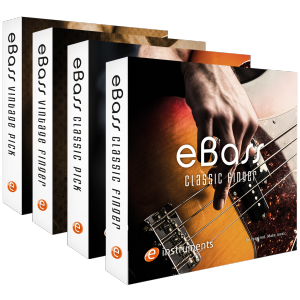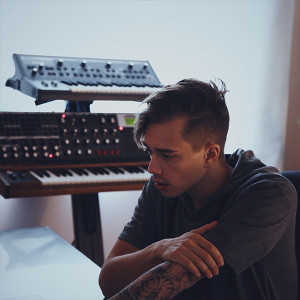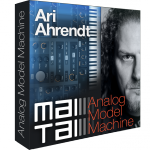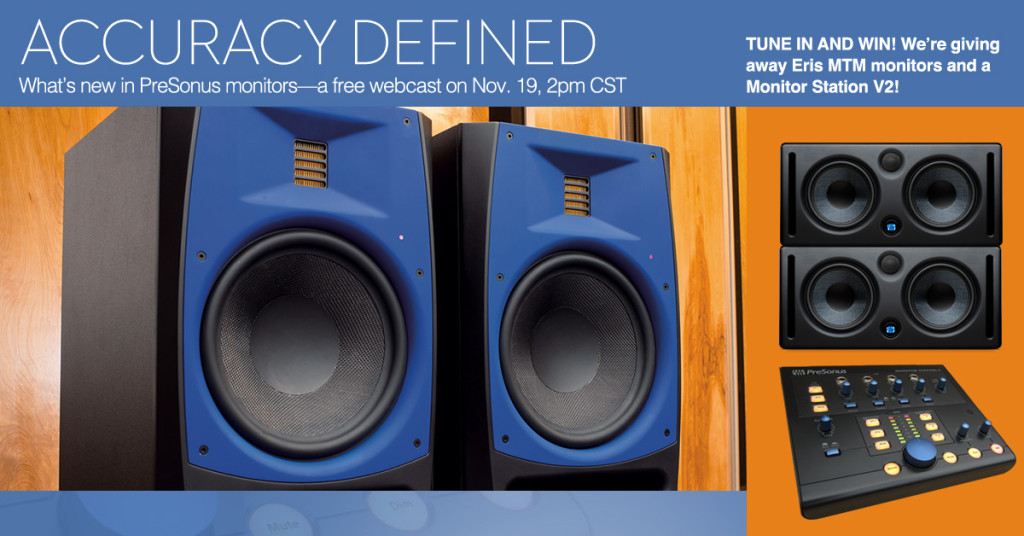Free: Recording in Studio One Made Easy
Getting started with home recording just got a whole lot easier this holiday season. Purchase any PreSonus audio interface and register it at my.presonus.com before January first and you will receive the Recording in Studio One Made Easy course from Home Recording Made Easy.
Home Recording Made Easy will teach you on how to do everything from hooking up your hardware to your computer, recording an entire song using a modest recording studio set-up and finally mixing that song using the tools in Studio One.
This series is nearly 3 hours in length and has 10 video sections. Whether you have switched from another DAW to Studio One or if you are brand new to home recording this series is for you. This is also the perfect enhancement when giving the gift of recording this Holiday Season.
Introducing the eBass Add-ons for Studio One 3
 [This just in from Thomas Koritke of e-instruments, who shared some valuable insights on the creation of our new eBass Add-ons for Studio One 3! These sample packs include VERY meticulously sampled recordings of a 1975 P-Bass in various styles. They’re available for all editions of Studio One 3: Artist, Professional, and Prime, and can be purchased on shop.presonus.com website or directly from inside Studio One.]
[This just in from Thomas Koritke of e-instruments, who shared some valuable insights on the creation of our new eBass Add-ons for Studio One 3! These sample packs include VERY meticulously sampled recordings of a 1975 P-Bass in various styles. They’re available for all editions of Studio One 3: Artist, Professional, and Prime, and can be purchased on shop.presonus.com website or directly from inside Studio One.]
We are really happy to see our eBass released! I hope the following gives you some valuable information on our instruments.
We recorded a 1975 Precision Bass in a studio here in Hamburg—actually the same studio that we used to record our Session Strings, Session Horns and Session Keys instruments. It is one of the few facilities left with a large and great sounding room.
We used a Millenia TD-1 tube channel for the Vintage Bass instruments, and an Avalon DI preamp for the Classic Bass. We also recorded the bass via an Ampeg SVT top with 112 speaker, just as a sound reference. However, we ended up using only the DI signals for our eBass instruments. The DI signal provides great flexibility for additional processing with amp simulators and EQ, so the reference amp recording was a tremendous help when we designed the Instrument+FX presets—we could always compare them to the real thing. Strings were medium 045-105 round-wound for the classic and the same gauge flat-wound strings for the vintage. The pickup set was the original from 1975.
The bass was performed by a completely unknown, but extremely patient bassist here from Hamburg. Sampling requires a very special skill set and what we ask a musician can be quite hard or boring for a famous virtuoso. The player has to be able to have great control over dynamics and sound as well as keeping a certain dynamic throughout the entire tonal range. He has to be very patient and controlled, should not produce any noise, should not move, and has to repeat notes several hundred times… it’s a painful process, but it’s worth it: with both flatwound and roundwound strings and two playing styles—pick and finger—for each string type, eBass provides THE classic Precision Bass sounds.
Despite the previously mentioned attention to details, I think the most interesting part of the product is in its scripting, sound design, and music loops. Our goal is to provide very flexible and easy to use great sounding bass sounds. As such, we designed these Add-ons with presets for different use cases. Some people love to perform a bass line on a keyboard. The performance presets are designed specifically for that. They include an intuitive legato function (legato on the same string–within a fourth interval), velocity switching for dead notes or harmonics, pitch bend control to trigger slides and hammer-on/pull-offs and even control over the left hand position on the neck via mod wheel. All articulations are instantly available.
Other producers are used to selecting different articulations via key switches. We have created the production presets for them. Here, all articulations are accessible via dedicated keyswitches. The production presets also feature left hand position control via mod wheel. Both preset types are available as “dry” Presence XT presets, or as Instrument+FX presets including a chain of Ampire, EQ and Compressor.
Finally, some musicians may just need some inspiration or use an existing bass line and modify it. Each eBass includes Musicloops in different styles, genres and complexity levels – from fairly basic to quite busy. They all come with a dedicated effects chain setting to match that specific style or genre.
All the best,
Thomas Koritke
e-instruments
DigiMax DP88 – A Legend Remade
The DP88 is here!
Introducing the DigiMax DP88—an 8-Channel A/D/A Converter with remote controllable preamps. The DP88 is the perfect compliment to PreSonus’ Studio 192—among other interfaces.
Paul Wright and Studio One
 After starting his career more than twenty years ago, Paul Wright finds himself with a trophy case of accomplishments. A multi Grammy, Dove, and Stellar award winner and nominee, Wright has worked on over 200 records as a writer, producer and composer. He’s been fortunate enough to work with the Brooklyn Tabernacle Choir, Donnie McClurkin, Fred Hammond, Gary Chapman, AsOne, Disney and many more. His film and television projects include: Made In America, Preaching to the Choir, Full House, and Martin—where he co-penned the theme song. Through his career, he’s held titles at Benson Records, Verity/Zomba, Harborwood/Zomba/BMG, and Nuspring/EMI. He’s currently the CEO of 360MusicWorx/Capital Christian/Universal Music.
After starting his career more than twenty years ago, Paul Wright finds himself with a trophy case of accomplishments. A multi Grammy, Dove, and Stellar award winner and nominee, Wright has worked on over 200 records as a writer, producer and composer. He’s been fortunate enough to work with the Brooklyn Tabernacle Choir, Donnie McClurkin, Fred Hammond, Gary Chapman, AsOne, Disney and many more. His film and television projects include: Made In America, Preaching to the Choir, Full House, and Martin—where he co-penned the theme song. Through his career, he’s held titles at Benson Records, Verity/Zomba, Harborwood/Zomba/BMG, and Nuspring/EMI. He’s currently the CEO of 360MusicWorx/Capital Christian/Universal Music.
We recently asked him about his experience with PreSonus and Studio One. With his years of experience recording and producing music, Wright knows what tools work best for him.
“Studio One came to my life when I knew I wanted to switch DAWs,” Wright says. “I was a longtime Pro Tools HD user and at that time I had a commercial facility. One thing that bothered me with most DAWs I was using was that they were NOT composition friendly. There’s usually a learning curve that kills the creative process because of the number of steps it takes to do the simplest of tasks. I found myself wasting time figuring out how to make the DAW do what I wanted—I spent more time clicking buttons than actually being creative and making music!”
After making the switch to Studio One, things were different—almost overnight. “Everything instantly became more productive for me on many levels. Composing, production, recording–it was a life changer. I found myself turning out projects more quickly and easily.”
When it comes to why Studio One is the best for Wright, it all comes down to quality and speed. “First and foremost? Audio quality. I found myself getting my work to sound great in less time using less plugins and processing,” Wright asserts. “As a composer and producer that uses many virtual instruments, the ability to get my MIDI converted to audio quickly was huge for me! Now in Studio One, the expanded Arranger features are killer, as well as the Scratch Pad. I also noticed that the mastering features were exactly what I needed, and in several cases have mastered many projects right in Studio One.”
Wright’s attempt to create an ideal workflow by using multiple DAWs was not void of challenges. “I used Pro Tools, Nuendo, and Studio One all at the same time, utilizing each of them individually to get what I was after,” Wright recalls. Nuendo was my mix platform, Pro Tools was for converting sessions coming in from other musicians, and Studio One was for everything else.” After completing an A/B test regarding sound quality, Wright found Studio One and Nuendo on top.
Wright suggests that “the only downfall for Studio One versions 1 and 2 was the mix features and the inability to easily connect them to other controllers.” He goes on to say, “I found that working with the SSL Matrix as my main console and controller, it wasn’t working the way I had hoped. However, with the recent release of Studio One 3, it looks like my SSL is working better than ever and I am loving what I am seeing”
Wright closes with a challenge.
“Studio One has changed the game for me personally, and is worth checking out if you haven’t already. I would challenge anyone regardless of the DAW they currently use, give Studio One a shot and watch it change the way you make music!”
Give As One a listen here.
PreSonus LIVE airs today: Accuracy Defined—What’s New in PreSonus Monitors
Join Justin Spence as he takes us on a tour of the latest monitoring offers from PreSonus: the R Series monitors and the Eris MTMs! He’ll also talk about monitor setup and monitor controllers like the Central Station and Monitor Station.
TUNE IN AND WIN! We’ll be giving away a pair of Eris MTM monitors and a Monitor Station!
Jake Owen: on the Road with PreSonus!
Jake Owen is in the enviable stage of his career where he can work with whatever gear he wants. As such, we’re flattered that he’s taking a complete PreSonus recording rig on his tour bus that includes Studio One, Sceptre Monitors, ADL preamps, and much more. Any musical idea that his band has during impromptu jams can be recorded right on the road, without needing to stop in a recording studio!
For more on Studio One, click here.
Willem Rebergen, AKA Headhunterz, Chooses Studio One 3
 CNN recently reported that “Electronic Dance Music (EDM) is a $6.2 billion industry” and “the fastest-growing music genre out there.” Through cult-like followings on social media, hundreds of worldwide festivals, radio airplay, and collaborations with pop artists, EDM artists continue their foray into and beyond the mainstream.
CNN recently reported that “Electronic Dance Music (EDM) is a $6.2 billion industry” and “the fastest-growing music genre out there.” Through cult-like followings on social media, hundreds of worldwide festivals, radio airplay, and collaborations with pop artists, EDM artists continue their foray into and beyond the mainstream.
One of these artists is Willem Rebergen, better known to his 172,000+ followers on Instagram as DJ Headhunterz. Rebergen kicked off his career in 2006 as a DJ and music producer, and quickly grew into one of the biggest names in the industry, recently performing at several major festivals, including Electric Daisy Carnival and Tomorrowland.
After eight years making hardstyle music, Rebergen was ready to tackle a new challenge. “Right now I’m translating my signature sound to something a bit different from what I used to do but I don’t necessarily want to settle in a single genre anymore,” he states. “I want to feel free to go where my heart wants to go. Everything changes—and so does my personal taste, so listening to that is the only way for me to keep tapping into my full creative potential. Who knows what I might make tomorrow?”
We recently chatted with Rebergen about where he wants to take his music, his creative process, and working with Studio One. “I have been using Studio One for about two and a half years now and I am currently on version 3,” Rebergen states. “I make EDM, so I would say I use Studio One for composing and sound designing. I basically use it for anything necessary to produce a song.”
A longtime Logic user, Rebergen was turned on to Studio One by a recommendation of a very wise friend. He was immediately hooked. “I had been on Logic for years, but became unsatisfied with the lack of development of the software since Apple bought it. I felt it got behind compared to other more forward-thinking companies making DAWs,” he asserts. “I tried Ableton but that wasn’t exactly what I was looking for either. I was excited to give Studio One a go—I’m always eager to test new software, I’ve always been kind of a nerd, honestly. Looking for the next thing that improves workflow or sound quality. Studio One immediately felt natural to me, it really didn’t take me long to get used to, and I think especially for people coming from either Logic or Cubase it will feel very intuitive right away.”
“When I started using Studio One, I was very happy to feel back in control of my audio editing. The cutting tool felt very “direct,” and I loved the slip editing tool which I didn’t have before. Automation was as tight as it could get, and very quick and convenient—which was also one of the reasons for my switch. That is how automation should be! When you make electronic music I often want to be very surgical with drawing in automation, and Studio One simply allows for this at all times, even under the pressure of latency-inducing plugins. Latency compensation is always on point!”
Another feature that made me fall in love with Studio One was Track Transform. It’s so much more flexible than in any other DAW that I know of, and opens up a whole new spectrum of working with content that otherwise would be literally frozen and untouchable.
“Furthermore, I have been working more quickly in Studio One than ever before. The browser changed my way of working completely, and motivated me to create a perfect personal library where all my hard work is stored and ready to put back into action. When I create a sound in a soft synth, I create a Musicloop by dragging it into my browser. This saves not only the synth preset, but also the MIDI sequence and effect Plug-ins. It even lets me play a preview when I select it in my browser, so I know exactly what I’m about to drag into my project. I could not think of a more convenient way to browse through my self-made sounds.”
“All of these functions have made it possible for me to feel much more creative while being in the actual creative process, and not being pulled out of it by having to search endlessly for that particular sound I’m looking for, or having to work around functions that are not doing what I want.”
“I also create a lot of macros to improve my workflow, I’m totally in love with the new arranger and scratchpad function which allows for me to be much quicker and intuitive when arranging my songs without making a mess.”
As a full-time producer, Rebergen’s working knowledge of Studio One runs deep. When pressed for workflow details, he’s much more open than many of his peers. “I recommend that Studio One users make full use of the Browser and the Musicloops,” he opines. “When I finish a song, I completely undress it and save all sounds I made in the form of channel presets, Musicloops, and audio files. With every song I make, my library expands—and whenever I’m in the creative process I can recall any sound I am looking for without having to get into sound designing or endlessly searching through sample libraries. I make sure that every sound I save in MY library is on point, so they rarely need a lot of tweaking to fit into a song and I can just get on with concentrating on the creative part.”
He’s also taken advantage of using other, prehaps modest applications in conjunction with Studio One to accellerate his already blazing workflow. “I keep an app open alongside Studio One called Sticky Notes. I type down all my newly-made key commands—yes, I constantly make new ones! I then force myself to use them all the time so they become a natural part of my workflow. Customizable key commands make everything so much quicker, and Studio One allows for using them for almost anything.”
“Studio One invites us to have the best workflow we have ever had,” Rebergen continues. “I can’t believe I had been able to keep up with making new songs in the total mess I was working in when I used Logic. With every update, PreSonus puts out come fantastic new features which shows that the team is eager to keep pushing forward. They actually listen to what users want, and notice what users have been missing out on while working with other software. Coming from Logic, Studio One it gave me much better audio editing, better automation, more overview, a better overall workflow. I could keep going…”
And going he is. Rebergen has his hands in a lot of different projects apart from his own. “Currently, I have a collaboration out with R3hab called “Won’t Stop Rocking” on Spinnin Records. Other songs I have released this year are: “Live Your Life” with Crystal Lake and “The Power Of Now” with Steve Aoki. And, of course, some solo tracks, as well.”
Rebergen closes with a shout-out to the PreSonus krewe. “Team PreSonus has the perfect mindset to create the perfect DAW. In my opinion it already is the best DAW out there, and it’s going to get even more awesome, I’m sure. I’m beyond grateful to have Studio One in my life!”
Free shipping if you spend $49.95 in our accessories store, including AVB and Dante Cards
Metric Tonne of Studio One Add-ons Added-on to shop.presonus.com
We’ve recently released a lot of loop content for Studio One. It’s all available exclusively at shop.presonus.com. We’ve got a little something for everybody—especially if you’re making hip-hop or electronic music of nearly any flavor, including Indian Dubstep, we’ve got a loop pack for you. Click on any of the titles below to learn about the packs, hear audio demos, and download! (You can also buy them directly from within Studio One 3.)
 From EarthMoments, we’ve got the Desert Oud; an ancient Iraqi instrument, Dubstep India; a blend of wub-wub basses with acoustic Indian instrumentation; and the Pure India bundle, which is a bundle of three packs that include gigabytes of traditional instruments, percussion samples, and vocals.
From EarthMoments, we’ve got the Desert Oud; an ancient Iraqi instrument, Dubstep India; a blend of wub-wub basses with acoustic Indian instrumentation; and the Pure India bundle, which is a bundle of three packs that include gigabytes of traditional instruments, percussion samples, and vocals.
 SampleMagic has been very prolific of late, covering all the basses. The most notable bass, of course, is the TB-303 in their Acid House pack. Further packs include the tape-echo saturated Future Dub; the stomping UK Garage of Future House; and the bevy of classic vintage Roland and LinnDrum hardware samples in New Wave. Ibiza-worthy Melodic Deep House and Festival Anthems round out the set. The details of these packs are too numerous to list in the blog, here, but click through any of the titles to learn more about the packs themselves. SampleMagic had planned to release a Vaporwave sample pack, but then this happened, effectively beating them to the punch.
SampleMagic has been very prolific of late, covering all the basses. The most notable bass, of course, is the TB-303 in their Acid House pack. Further packs include the tape-echo saturated Future Dub; the stomping UK Garage of Future House; and the bevy of classic vintage Roland and LinnDrum hardware samples in New Wave. Ibiza-worthy Melodic Deep House and Festival Anthems round out the set. The details of these packs are too numerous to list in the blog, here, but click through any of the titles to learn more about the packs themselves. SampleMagic had planned to release a Vaporwave sample pack, but then this happened, effectively beating them to the punch.
 MVP has brought in five new packs bristling with pure hip-hop bombast—but that’s not all. The Trevor Lawrence Jr.-produced Sound Squad offers nearly 2 gigs of hip-hop, EDM, R&B, and pop elements. Mix and match them to make your own styles! Sound Gang offers loops, riffs, and one-shot samples for modern urban production. is another modern hip-hop kit full of big drums and grimy synths, as do Magnaa Carter: Reloaded and OVXO Vol 2. Hook City Platinum Edition rounds out the offerings with an R&B and Soul-tinged vibe, produced by first-call musicians, writers, and engineers.
MVP has brought in five new packs bristling with pure hip-hop bombast—but that’s not all. The Trevor Lawrence Jr.-produced Sound Squad offers nearly 2 gigs of hip-hop, EDM, R&B, and pop elements. Mix and match them to make your own styles! Sound Gang offers loops, riffs, and one-shot samples for modern urban production. is another modern hip-hop kit full of big drums and grimy synths, as do Magnaa Carter: Reloaded and OVXO Vol 2. Hook City Platinum Edition rounds out the offerings with an R&B and Soul-tinged vibe, produced by first-call musicians, writers, and engineers.
 While not technically a loop pack, we’d be remiss to overlook the Analog Model Machine for Mai Tai. 200 synth presets lovingly crafted in the mold of Vangelis, Jean Michel Jarre, and more, from our very own Ari Ahrendt, Quality Assurance Specialist at PreSonus Software. You can get your Klaus Schulze on without devoting a room of your house to expensive analog electronics.
While not technically a loop pack, we’d be remiss to overlook the Analog Model Machine for Mai Tai. 200 synth presets lovingly crafted in the mold of Vangelis, Jean Michel Jarre, and more, from our very own Ari Ahrendt, Quality Assurance Specialist at PreSonus Software. You can get your Klaus Schulze on without devoting a room of your house to expensive analog electronics.


